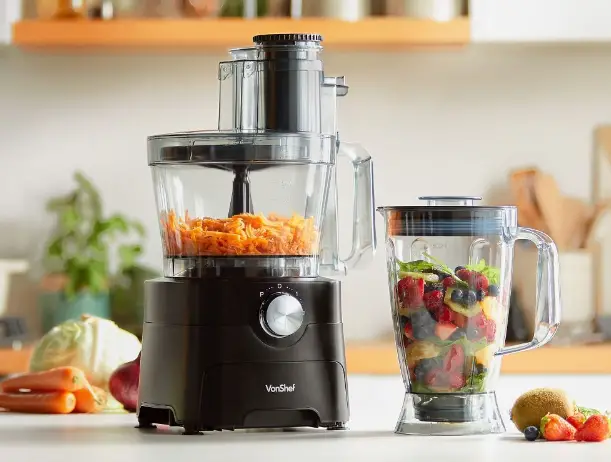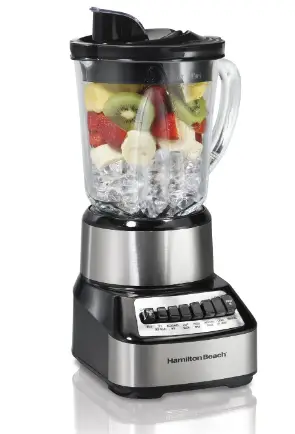Food processors and blenders have similar tasks but aren’t interchangeable. Blenders mostly purée or smash ice; they blend drinks, drizzles, and dips. Food processors may also slice, grate, shred, and dice. When eating with a fork or spoon, use a food processor.
Read Also: Best Blenders
What is a food processor?
Food processors chop, mix, purée, emulsify, grate, and shred. This appliance stands out for its settings and blade.
What is a blender?
Blenders, mixers, and liquidizers combine, smash, purée, and mix food and other things. A stationary blender has a container with a revolving metal blade and an electric motor at the base.
Also Read: Best Food Processor
Food processor vs. blender comparison:
Depending on the type, a blender or food processor may have various attachments. However, these features are very consistent among blenders and food processors.
- It is possible to slice, shred, and chop with a food processor.
- You can liquify, purée, or crush the ice with a blender.
- Discs and blades galore comprise a food processor.
- A blender has a stationary blade and a tall, narrow container for easy dispensing.
- A food processor’s big bowl accommodates ingredients that are also sizable.
The difference between blender and food processor
Below is the food processor and a blender difference.
- Blenders utilize fixed blades: Most older models of blenders only have room for one fixed blade in the jar. This blade might have many points at various angles to mix substances thoroughly. You can pulverize ice cubes, purée fruits and vegetables, and even liquefy them with only one blade.
- Food processors have many blades: Food processors have blades and discs. Work bowl blades to puree, chop, mix, and knead. Some food processors have a whisk attachment for whisking, whipping, and stirring. Food processor discs sit above the feed tube in the work bowl and slice, shred, and dice when materials are fed in.
- Tall Jar Blenders: Tall sides assist in combining liquids in a blender jar. The jar’s height and design help the components combine evenly. The pitcher-like jar generally has a grip and a pouring lip or beveled sides.
- Food processors have wide bowls: Large, flat blades and discs in food processors slice and shred. A more extensive basin allows the device to prepare entire meals, but giant food processor bowls hold more.
- Measurements and Power: Food processors can be as large as 14 cups. Personal blenders are 2 cups, and industrial blenders are 14 cups. Pick a blender or food processor that fits your needs.
Similarities between a food processor vs. blender
Blenders and food processors work similarly. Blenders and food processors usually have a base-mounted motor. On top of the motor base, a jar or work bowl carries blades or discs that handle or combine food. You can use some recipes with both appliances, but each has strengths.
What do you use a blender for?
Blenders are great for liquid or smooth recipes. The tall, thin blender jar creates a vortex that attracts the contents to the blades. Blenders are stronger than food processors. This speeds up blade spinning, smoothing out complex substances. Get blender usage advice for various recipes.
- Use a blender if your recipe calls for essentially liquid or soft components, like a smoothie or soup. Also, use a blender if you’re making anything to drink or eat while chewing.
- Warm and froth milk for coffee, tea, or cocoa, or combine rice milk and hot chocolate. The whirling blades and downward pull warm the milk and generate bubbles and light foam.
- Blender-mixed components provide a smooth, fluffy texture. Make lemon mousse or pear clafouti.
- Use a blender for velvety smooth tomato soup, lobster bisque, or cantaloupe gazpacho.
- Homemade applesauce blends well. Create your blended fruit combination.
- Use a blender to make frappées or frozen cocktails like watermelon sangria or daiquiris.
- Grind almonds in a high-powered blender to make gluten-free flour.
- These frozen treats need blenders. Mixing various ingredients and regulating the amount of milk may produce frothy shakes to sip via a straw or thicker mixes to consume with a spoon. For single servings, use an immersion blender or your countertop blender.
- Blend unsweetened coconut flakes to make coconut oil in minutes. None added!
- Granulated sugar and cornstarch form fresh baker’s or confectioner’s sugar. If you run out during a recipe, you can make powdered sugar in minutes.
- If you’re a milkshake addict who fuses texture and flavor, a blender can help.
- Pure roasted veggies or fresh fruits for a picky eater. A blender helps infants learn to appreciate fresh, healthy meals. And when you create it yourself, you control the components.
- Blenders make salsa smoother and more liquid.
What is a food processor used for?
Food processor blades spin slower than blender blades, allowing for chunkier output. Larger s-shaped blades cut slowly and precisely. Food processors feature a variety of blades. The feeder tube lets you add little amounts and push them toward the blades. So what to do with a food processor?
- Without adding liquid, food processors can cut, slice, or grate.
- You can grind day-old bread in seconds. Customize your combination using herbs.
- Food processors have a batter blade to knead with heat. Pulse, and don’t overdo it. The over-kneaded dough has harsh gluten and won’t rise.
- Use the shred disc to make sauces in minutes. Fresh cheese melts and tastes better than pre-shredded cheese.
- Blenders may cut vegetables in tiny batches, but they generate more liquid, which affects their texture and appearance.
- Faster blade speed makes it tougher to monitor chopping progress.
- Food processors produce sauces fast and make versatile toppings. You may adjust the size of the bits to achieve the desired texture.
- Ricing veggies reduces carbohydrates and add variety to recipes. The food processor’s sharp blades cleanly mince florets.
- You may approximate grinding without a meat grinder by mincing meat in a food processor. Pulse the meat to your liking. Raw meat inside a blender will wrap around the blades.
- Prepare fresh fruits, vegetables, and more with a food processor to introduce kids to solids. Pulse ingredients to get chunkier purees, sliced carrots, and more.
- Food processors produce chunky salsa. A blender or food processor can purée vegetables, herbs, and spices if you want a smooth salsa or sauce.
Speed up meal prep with a food processor.
If you cook frequently, you know how time-consuming it can be to prepare meals. Fortunately, several kitchen appliances can make cooking easier. One of these is the food processor.
Different models on the market today have various features and price ranges, depending on what you need to process. So you can choose a basic or a more advanced model, whatever fits your needs best.
How Does a Food Processor Work?
Like most other appliances, a food processor works by using blades to chop ingredients. It may also have a dough blade for kneading bread and dough, shredding meat or cheese, chopping nuts, and grinding coffee beans (making salsa).
If you want to know more about the different types of food processors, go here.
The Cuisinart Pure Indulgence Processor is a perfect example of a food processor with all the features needed to prepare a wide variety of foods.
A food processor and mixer
Install the mixing blades to utilize a food processor as a mixer. After installing, you may use your food processor. When using a food processor, be careful not to overfill it.
The food mixer and processor combine.
Install the mixing blades to utilize a food processor as a mixer. After installing, you may use your food processor. When using a food processor, be careful not to overfill it.




Pingback: Best Food Processor 2022 – Pantry Raider
Pingback: Best Blenders ‘2022 – Pantry Raider